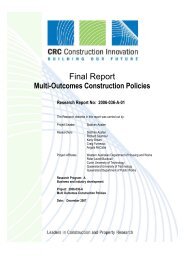Dispute Avoidance and Resolution (literature review) - Construction ...
Dispute Avoidance and Resolution (literature review) - Construction ...
Dispute Avoidance and Resolution (literature review) - Construction ...
You also want an ePaper? Increase the reach of your titles
YUMPU automatically turns print PDFs into web optimized ePapers that Google loves.
7. <strong>Dispute</strong> avoidanceThe avoidance of disputes has, over a number of years, been addressed both at an industrywide level <strong>and</strong> at a project specific level. At an industry level considerable attention hasbeen given to encouraging a cultural shift so that the industry moves from being adversarialto being dispute averse. There have been numerous initiatives both in Australia <strong>and</strong> in theUK to with the objective of minimising the perceived adversarial nature of the industry (this isillustrated in Figure 5.1). For example Commissioner Gyles introduced the Partneringconcept into Australia through the aegis of a Royal Commission in 1991.With respect to dispute avoidance <strong>and</strong> resolution, the basic maxim which is frequentlyexpressed is, that ‘prevention is better than cure’. The industry has been repeatedlyadmonished <strong>and</strong> encouraged to embrace modern management concepts such as partnering<strong>and</strong> alliancing with an emphasis being placed on an early involvement in the decision makingprocess by the key stakeholders including clients, contractors <strong>and</strong> building users. Therelatively recent emergence <strong>and</strong> rapid uptake of alliancing is testament to the movementtowards the creation of dispute-averse relationships. The fundamental premise with respectto dispute avoidance being that the likelihood of disputes occurring will be significantlyreduced if a pro-active project environment can be created in which change management isan accepted tool. Whilst procurement methods such as alliancing are seen as beingconducive to a creating a non-adversarial environment that is not to say that co-operativerelationships cannot be achieved in more traditional forms of contracting such as lump sum<strong>and</strong> design <strong>and</strong> construct.Figure 6.2 illustrates a raft of modern management concepts all of which can contribute tocreating an environment which is likely be non-adversarial <strong>and</strong> which may assist in theavoidance of disputes. Many of these concepts take into account the roles of stakeholders<strong>and</strong> the alignment of organisational <strong>and</strong> individual goals.Figure 6.1 Pareto influence curve with management concepts superimposed (afterMcGeorge <strong>and</strong> Palmer)Project 2007-006-EP Page 40 of 62
















